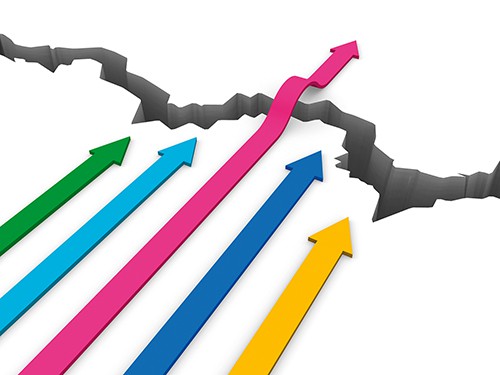In a new commentary, two doctors warn that understanding how the new coronavirus affects children is critical for accurately assessing the impact of the COVID-19 global pandemic, as well as for figuring out ways to treat or prevent the disease.
The Essential of Preparedness
The Essential of Preparedness

“Give me six hours to chop down a tree and I will spend the first four sharpening the axe.”
– Abraham Lincoln
Prior to COVID 19, our organization had a strong Business Continuity Plan, which was refined and made stronger as a result of this crisis. It has guided every one of our actions and is structured into four major areas of response:
• People
• Workplace/Operations
• Finance
• Information Technology
Each area of response included three phases: Phase I: Prevention and Containment, Phase II: Stabilization, and Phase III: Transition to “New” Steady State/Emerging Opportunities.
As I reflect on our efforts over these past weeks, I have come to appreciate, in ways I never have before, the value of a clear, transparent and thoughtful plan.
Our staff, our clients, our donors, our funders and our partners rely on us to make decisive and informed decisions.
To do so, preparedness is essential.
During the first two weeks (Phase I) when there were many, many more questions than answers—we knew what to do. We set up a Command Center and Employee Hotline, established a leadership team, started to communicate regularly to board and staff and initiated an intense impact analysis and scenario planning with company leaders. We followed the plan.
During the last 3 weeks (Phase II), our goal was to stabilize the company and mitigate as much loss as possible. As the possible scenarios we ran became reality, we took action. Not every action we took was easy, but what was reassuring is that we knew what to do and when to do it. We:
• Increased staff communication;
• Worked closely with funders;
• Carefully managed the human impact of program closures, such as schools and
child development centers on both staff and families;
• Leveraged our strong technology infrastructure to use virtual platforms to provide
services when possible;
• Trained staff on how to provide telehealth services and helped supervisors learn how
to be effective in supervising remotely; and
• For services in high demand, such as our Total Facilities Management enterprise—
we adjusted to meet the need.
We have recently begun the rigorous task of preparing for the end of COVID-19 (Phase III)—whenever that will be. This involves detailed discussions about how we intend to bring people back to work, exploring practices we employed during the crisis that we may want to continue post-crisis, and aggressively going after every resource available to us by government and the philanthropy to mitigate further long-term organizational impact.
We are absolutely committed to coming out of this crisis—better and stronger.
Given all that is happened, it is preparedness and planning, that in the end, is making the most significant difference.
Preparing for the New Normal
Preparing for the New Normal

There are many discussions occurring around the world about how the COVID-19 crisis will change business and supply chains moving forward. Many people around the world are thinking about possible scenarios and it appears the majority is convinced that there will be a “new normal.”
I don’t have a crystal ball, nor can I predict the future, but I too feel confident that we are not going back to what we knew as normal.
So, what does that mean? What does our “new” normal look like. A recent article by Forbes points to at least part of the future where the author suggests that there will be a combination of two concepts: “design everywhere, produce everywhere” with “deliver personalized products fast, in a sustainable and affordable way for the mass market.”
McKinsey also has some interesting perspectives. “For some organizations, near-term survival is the only agenda item. Others are peering through the fog of uncertainty, thinking about how to position themselves once the crisis has passed and things return to normal…While no one can say how long the crisis will last, what we find on the other side will not look like the normal of recent years. Through it all, technological innovation will continue, and the value of increasing human knowledge will remain undiminished.”
I have tried to apply some of this thinking to the nonprofit human service environment.
I believe that we are going to leverage our experiences and learning from this crisis to establish more efficient ways to provide human services. The integration of online learning and telehealth will drive an entirely new model of service delivery in some of our core programs: workforce development, clinical services and adult learning activities. This may result in reduction of travel by our clients and an increased ease of access to services for many. It may expedite achievement of contractual requirements.
I believe we are going to leverage technological platforms as a vehicle for staff connection—replacing many of our meetings with video conferencing. This has many upsides including increased productivity and reduced travel.
Right now, I am communicating with staff much more frequently. It is my intent to maintain this frequency of communications. Staff have expressed appreciation for the connection with company leadership resulting from these e-mail messages and videos—the sense that they are not in this alone. There is great value in ensuring a culture where there is a strong sense that leaders and staff are “in this together” whatever this is.
We have been focused on how to ensure that remote work is effective and productive and tried to support our over 1000 employees working at home around the world. This has resulted in a renewed approach to outcome-based supervision, new strategies for motivation, new ways to promote team learning. This will continue.
There is more learning to come, more innovation, more insights and from that…more hope.
As always, I welcome your thoughts.
We Can Do This!
We Can Do This!

I recently read an article by Saunj Fyffe on the American Society for Public Administration website that rang true. He stated, “The hardships experienced by state and local governments place huge constraints on nonprofit operations nationwide. Instead of waiting to see what will happen, we need a call to action for nonprofits to think differently, get creative and proactively find new ways to diversify and secure financial resources needed to survive.”
With the heightened demand for services in these difficult times, we must all find innovative and creative ways to deliver the interventions our clients need and, potentially, with less staff and less resources.
At The Fedcap Group we are focusing on this need for innovation every single day. We are asking ourselves: What else can we do? How can we do what we have always done in a different way? How can we connect to the people who need us?
As nonprofit and government leaders—I know you are doing the same.
During the need for social distancing, it is imperative that we all find ways to leveraging every aspect of our technological foundation to connect—with our boards, staff, clients, donors and funders. We need to all find ways to provide as many services as possible via phone and video-conferencing platforms. We need to ensure that our clients receive the vital connection and human “touch”, as well as the critically needed interventions whether it be speech pathology for children in early intervention services, counseling for individuals with behavioral health needs, or educational services for children and adults If we can think of an effective, secure way to engage in the clients we serve—that is what we all must be doing.
We also need to find ways to stay connected to staff. Here are some of what we are doing:
• Sending out frequent updates and encouraging messages via e-mail, intranet and video.
• Providing webinars on topics, such as working effectively and productively at home, providing engaging telehealth services, managing stress during crisis and more.
• Developing newsletters that provide tips and strategies to manage stress, find creative ways to entertain your children, good news from around the world to lift spirits and more.
We need to reach out to board and donors, sharing our specific needs. We have done so and their response has been overwhelming…from significant monetary donations to the purchase of cases of diapers and toiletries for families in need.
We need to work side by side with government to secure as much funding as possible to maintain pre-crisis level services. Our government partners know that we are an imperative link in the service chain. They do not want us to fail.
Blogger Aki Kaltenbach reminds us that “Nonprofits can be some of the most innovative and creative organizations because they often have to make the most of limited resources.”
We know how to find solutions—even in the most challenging of times.
Support The Fedcap Group Emergency Fund
Support The Fedcap Group COVID-19 Emergency Fund
Click here to contribute to The Fedcap Group Emergency Fund, which will provide critical needs to the communities we serve during the COVID-19 pandemic.
We are grateful for your generous support!
Crisis and Leadership
Crisis and Leadership
“The words hope for the best and plan for the worst have never resonated with me so much as we have worked to navigate our international company through the ever-changing realities of COVID-19.”
These are uncertain times. I am not someone who likes uncertainty—and I ask many, many questions in order to gain clarity in any situation. I like to dig deeply into complex problems, clear the noise and make decisions. Yet during these times, there simply may not be answers.
So what do we do?
The way a leader behaves and acts during a crisis will uncover their ability to lead-period. It will uncover their willingness to take prudent and yet decisive action during a time when there is no manual. It will uncover their ability to calm the waters when others around them are panicking. It will demonstrate their ability to learn and rapidly course correct as circumstances indicate. It will show to others their innate character.
Don’t Allow Your Emotions To Get The Best Of You
In times of crisis, leaders invariably find themselves in the midst of a stressful and tense atmosphere. Now is the time to take charge of your thoughts, emotions and the way you deal with problems.
Remain Positive To Remain Productive
Positivity is the fuel for productivity. When the chips are down, you can choose to either get caught up in all the negativity surrounding you, or you can choose to do something positive about it. There’s always a choice.
Manage Expectations
When crisis strikes, people want to get over it as quickly as possible. As a leader, this is the time to face the situation and learn the magnitude of the problem. Let your staff know it might be a while until the storm passes and prepare them for the long and hard battle ahead.
Exercise Your Fearlessness
Fear is contagious and so is courage. If your demeanor reeks of fear, your employees will feel a greater sense of fear. You cannot afford to project yourself as someone who is not sure of his ability to lead or is short on confidence. Demonstrate the kind of courage that makes people want to follow you.
I have also found that the insights of Patrick Collison, founder of Stripe, to be especially helpful. In an article published by the Knowledge Project entitled Preserving our Optionality Collison wrote: “How do we prepare for a world that often changes drastically and rapidly? We can preserve our optionality. We don’t often get the advice to keep our options open. And we should. We live in a world that’s constantly changing, and if we can’t respond effectively to those changes, we become redundant, frustrated, and useless. Instead of focusing on becoming great at one thing, there is another, counterintuitive strategy that will get us further: preserving optionality. The more options we have, the better suited we are to deal with unpredictability and uncertainty. We can stay calm when others panic because we have choices.”
This rings so true for me, especially given the current times. Optionality means that we are always preparing for a variety of possible outcomes. We assume the next challenge is around the corner and we are constantly listening to diverse voices in order to be prepared. And we position ourselves to keep as many options open as possible. This optionality pathway cannot simply start during a crisis but must be a part of steady state. At the Fedcap Group, this has been one of our mantras: Diversity in programming results in diversity in options. So in this time of uncertainty, let’s find strategic ways to preserve our options. Let’s be smart, making decisions that can weather this storm. And in the meantime, breathe. I want to share a poem with you that has great meaning to me and when things seem overwhelming, I listen to it.
Commitment During Crisis
Commitment During Crisis

Dedicated staff of The Fedcap Group are taking extraordinary steps to continue to assist those we serve as the nation struggles to contain the coronavirus pandemic. In the face of increasing hardship and a dearth of resources and support, our people are stepping up.
 Easterseals New York’s Project Discovery is an integrated educational program for preschoolers that includes special education services, as well as an Outreach Program, providing food, clothing, housewares and toys to the neediest residents of Port Jervis. Over 165,000 pounds of food are distributed annually to children and families in need.
Easterseals New York’s Project Discovery is an integrated educational program for preschoolers that includes special education services, as well as an Outreach Program, providing food, clothing, housewares and toys to the neediest residents of Port Jervis. Over 165,000 pounds of food are distributed annually to children and families in need.
Each morning bread, produce and other items are displayed on a table in the parking lot for residents to pick up as needed, to supplement the food distributed at monthly outreach events.
“Recently, instead of receiving over 1,200 pounds of bread a month, we are getting five loaves. It’s getting quite serious here,” said Barbara Kuczyra, Outreach Coordinator and School Nurse for Project Discovery.
Our Total Facilities Management teams are out in full force working 24/7 to clean and sanitize facilities throughout New York, Boston, Virginia and Delaware. “The demand is significant and we are hiring new staff to meet the needs, all the while ensuring the safety of our dedicated staff,” says Steve Coons, President of Fedcap Rehabilitation.
In addition, our residential care workers and home health aides are providing direct care to some of society’s most vulnerable.
 The Fedcap Group’s Food Arts Center is working 24/7 to address food insecurity among people impacted by the COVID-19 pandemic. Partnering with Migrant Kitchen, the Food Arts Center is producing over 1000 meals per day, providing free meals to healthcare workers and their families, including frontline workers at the Covid-19 treatment units at Bellevue Hospital Center, Lenox Hill Hospital, and Memorial Sloan Kettering.
The Fedcap Group’s Food Arts Center is working 24/7 to address food insecurity among people impacted by the COVID-19 pandemic. Partnering with Migrant Kitchen, the Food Arts Center is producing over 1000 meals per day, providing free meals to healthcare workers and their families, including frontline workers at the Covid-19 treatment units at Bellevue Hospital Center, Lenox Hill Hospital, and Memorial Sloan Kettering.
In addition, the Food Arts Center has been hosting Feed the People, which is producing and delivering emergency meals to families and individuals who are housebound or have food security issues.
 The Fedcap School in Orange, New Jersey closed on March 18th as part of a statewide effort to contain the coronavirus. Social Workers, Counselors and Job Coaches are making wellness check-in daily calls and are available to any student in need. Staff are delivering breakfast and lunches to the entire student population.
The Fedcap School in Orange, New Jersey closed on March 18th as part of a statewide effort to contain the coronavirus. Social Workers, Counselors and Job Coaches are making wellness check-in daily calls and are available to any student in need. Staff are delivering breakfast and lunches to the entire student population.
The mood around the Fedcap School Staff is “unified and strong,” said Principal Luanne Macri. “We are teachers. We care about our students, and our population depends on us for far more than educational achievement. This is uncharted territory for everyone, but we are in this together, and we will be there for our students.”
Easterseals New York is on the front line providing child care services to our first responders and health care providers.
 “I am so proud that our Easterseals staff are stepping up and ensuring the availability of child care during this time of crisis”, said Don Harreld, Executive Director of Easterseals New York.
“I am so proud that our Easterseals staff are stepping up and ensuring the availability of child care during this time of crisis”, said Don Harreld, Executive Director of Easterseals New York.
Our Fedcap Inc. team is working around the clock to stand-up a new service delivery system in Canada (www.fedcapcanada.org), some staff getting stranded there for weeks at a time.
Share on
Recent Posts
Crisis and Leadership
Crisis and Leadership

“The words hope for the best and plan for the worst have never resonated with me so much as we have worked to navigate our international company through the ever-changing realities of COVID-19.”
Like many of you, I have been reading nonstop about COVID-19 specifically and about pandemics in general–trying to glean any wisdom I can from experts in the field and from historical events. I was struck by the comments of Dr. Anthony Fauci, Director of the National Institute of Allergy and Infectious Diseases who said “When you combine a pandemic with uncertainty, you get a powerful formula for fear and even panic. And that is why those in leadership positions need to step to the forefront and be a positive presence for those they lead.” We all know that when adversity strikes, people are looking for direction and guidance, and that’s why leaders must exert their influence to shape the best way forward.
During this time, I have found myself reflecting on the quote by James Lane Allen, a 19th century novelist, “Adversity does not build character—it reveals it.” The way a leader behaves and acts during a crisis will uncover their ability to lead-period. It will uncover their willingness to take prudent and yet decisive action during a time when there is no manual. It will uncover their ability to calm the waters when others around them are panicking. It will demonstrate their ability to learn and rapidly course correct as circumstances indicate. It will show to others their innate character. Adversity shines a light on talent. Individuals in the organization who may have gone unnoticed suddenly find themselves in the spotlight with an opportunity to apply their skills to emerging problems. They rise to the occasion.
In a 2017 article in Forbes Magazine I found a set of recommendations for leadership in crisis that stuck with me and I have relied on over the past month:
Don’t Allow Your Emotions To Get The Best Of You
In times of crisis, leaders invariably find themselves in the midst of a stressful and tense atmosphere. Now is the time to take charge of your thoughts, emotions and the way you deal with problems. Anything else can be interpreted by employees as a loss of control.
Remain Positive To Remain Productive
Positivity is the fuel for productivity. When the chips are down, you can choose to either get caught up in all the negativity surrounding you, or you can choose to do something positive about it. There’s always a choice.
Manage Expectations
When crisis strikes, people want to get over it as quickly as possible. As a leader, this is the time to face the situation and learn the magnitude of the problem. Let your staff know it might be a while until the storm passes and prepare them for the long and hard battle ahead.
Exercise Your Fearlessness
Fear is contagious and so is courage. If your demeanor reeks of fear, your employees will feel a greater sense of fear. You cannot afford to project yourself as someone who is not sure of the ability to lead or is short on confidence. Demonstrate the kind of courage that makes people want to follow you.
Never Waste A Good Crisis
Churchill’s quote is imminent. In the world of business, we are often guilty of not challenging the norm; we are instead satisfied with following procedure and tradition. It takes insight and not a little courage to question your leaders as to why are things done the way that they are? However, in times of crisis there seems to be more latitude to do so – management in fact is actively seeking input it seems. Leading companies nowadays recognize this and cultivate a more open, questioning climate within the office at all times because a degree of continual review is healthy within a business.
Mission Driven Opportunity: Going Global
Mission Driven Opportunity: Going Global

When an American nonprofit organization expands its operations to deliver service internationally, there is a tremendous amount to consider. Global initiatives do not happen overnight; they require significant preparation. To obtain buy-in from the board and funders alike, there needs to be a compelling story—one that is supported by research, analysis and a plan for success. The organizational leaders need to fully contemplate the needs that exist within the country, where the needs are most pressing, and the most efficient way to bring its experience and expertise to other regions of the world. In addition to what makes sense geographically, leaders need to consider how to integrate with the culture of another country, meet legal and tax requirements, understand government contracting, recruit talent, and much more.
In developing its global network, which now covers 22 states in the US, the United Kingdom and most recently Canada, The Fedcap Group has a deep appreciation for the complexities and the benefits of becoming an international company. When expanding to the UK, we began by holding a series of conversations with government funders to understand the current need and gaps in the existing delivery system. We also sought out organizations and seasoned professionals in the area who were familiar with the bidding and contracting process. Finally, we looked for partners or companies interested in combining with The Fedcap Group. In a Mission Box blog about how U.S. nonprofits can avoid the pitfalls of operating abroad, Grace Davies validated this approach, “Consider whether you could further your charitable goals by supporting the work of another charity already qualified to operate in a given foreign country.” She adds, “This is an excellent way to get your foot in the door and begin to become a known entity.”
A MUSE blog from RSM, an international financial consulting group, on how to plan strategy and build local relationships, suggests creating at least a five-year strategic plan for expanding into other countries. This is also in keeping with the approach taken by The Fedcap Group. In our 2015 Strategic Plan, we set a goal to expand internationally by 2020. We spent the next three years ensuring we had the talent, technological infrastructure, partnerships, systems and structure to succeed in the international marketplace. We continue to improve our strategies and approaches to integrating operations and cultures into countries outside the U.S.
Further, as Lakshimi Sarma Ramani points out in her general counsel blog, Outside GC, “Not all countries have the same legal definition around what a charitable mission or purpose is under the local legislation, and not all countries consider charitable organizations to be tax exempt.” Laws involving the transfer of funds and information are also different from those of the US, as are the privacy laws in Europe and Canada, so transmitting data may be an issue. You will need an expert who is “familiar with cross border transactions to ensure that you are complying with requirements for data collection, use, transfer, and storage, and the right to be forgotten. When identifying people to serve on the Boards of our international companies, we sought to fill gaps in our knowledge through bringing on board members who were knowledgeable and could assist us in our efforts. We also secured outside council.
While international expansion can be complicated, if an organization believes that it has a mission driven opportunity to make a difference, it is certainly worth the challenges. The Fedcap Group has experienced tremendous results in “going global” in our workforce development practice area. With contracts in England, Scotland, and Canada, internationally we are serving over 15,000 individuals on public assistance who seek employment and self-sufficiency. We have engaged government and business as true partners, and we are putting people to work.
The Changing Nature of Gendered Jobs
The Changing Nature of Gendered Jobs

The Fedcap Group is about long-term economic well-being. It is about ensuring that vulnerable populations have the tools, skills and resources to succeed, to complete their education, raise a family, to have a safe place to live, health care when a family member is ill and a savings account for that predictable rainy day. As such, we track job trends carefully. One of the trends we monitor is gendered jobs. These are jobs that are designated as being male or female in nature.
The gender composition of jobs matters for reasons of equality. Research tells us that designating a job as “female” can automatically diminish its authority, even among the minority of men in the field. Fields with a majority of men pay 21 percent more than those with mostly women. In a recent article by Business News Daily, the author cites that decades of man-as-breadwinner stereotyping has led to the view that if a job is high-skill and high-paying, it’s man’s work and when a profession is arbitrarily assigned to men, it’s perceived as more credible.
Thankfully, today’s generation is breaking down some of these gender barriers as they enter their work lives. And jobs are increasingly becoming gender neutral.
The New York Times has been following historic job stereotypes in a series of articles by Claire Cain Miller, on how race, ethnicity and gender have contributed to who does what work. “Women have typically entered occupations when men find better ones, and immigrants have filled the ones women left behind. In the 1800s Irish men replaced native born white women in textile mills. The women moved to middle class jobs like teaching, which native born white men were leaving.” As Miller reported, this pattern has not changed with today’s immigrant population.
Today 23 percent more women are in male-dominated occupations, such as CEO, lawyer, surgeon, or web developer, according to a study reported in Business News Daily. And the good news is that the growth in women’s employment in male dominated industries is not just about desk jobs. As Miller wrote with Jed Kolko in 2018, “The fastest growth has been at the building site and on the factory floor. The Bureau of Labor Statistics projects that employment in male dominated occupational sectors will grow 4.1 percent between 2016 and 2026, half the rate of mixed and female dominated sectors, 8.3 percent.” The tight labor market has assisted in the ability of women to enter traditional male fields. “In a tight labor market, firms give workers (such as women) a chance they would not otherwise consider,” said Lawrence Katz, a labor economist at Harvard. “The tight labor market could facilitate longer-term change if it demonstrates to firms that they should be more open to women in previously male-dominated areas.”
The Fedcap Group is optimistic that the gradual decrease in gendered jobs will enhance the ability of those we serve—especially women living in poverty—to obtain living wage jobs and secure long-term self-sufficiency.

